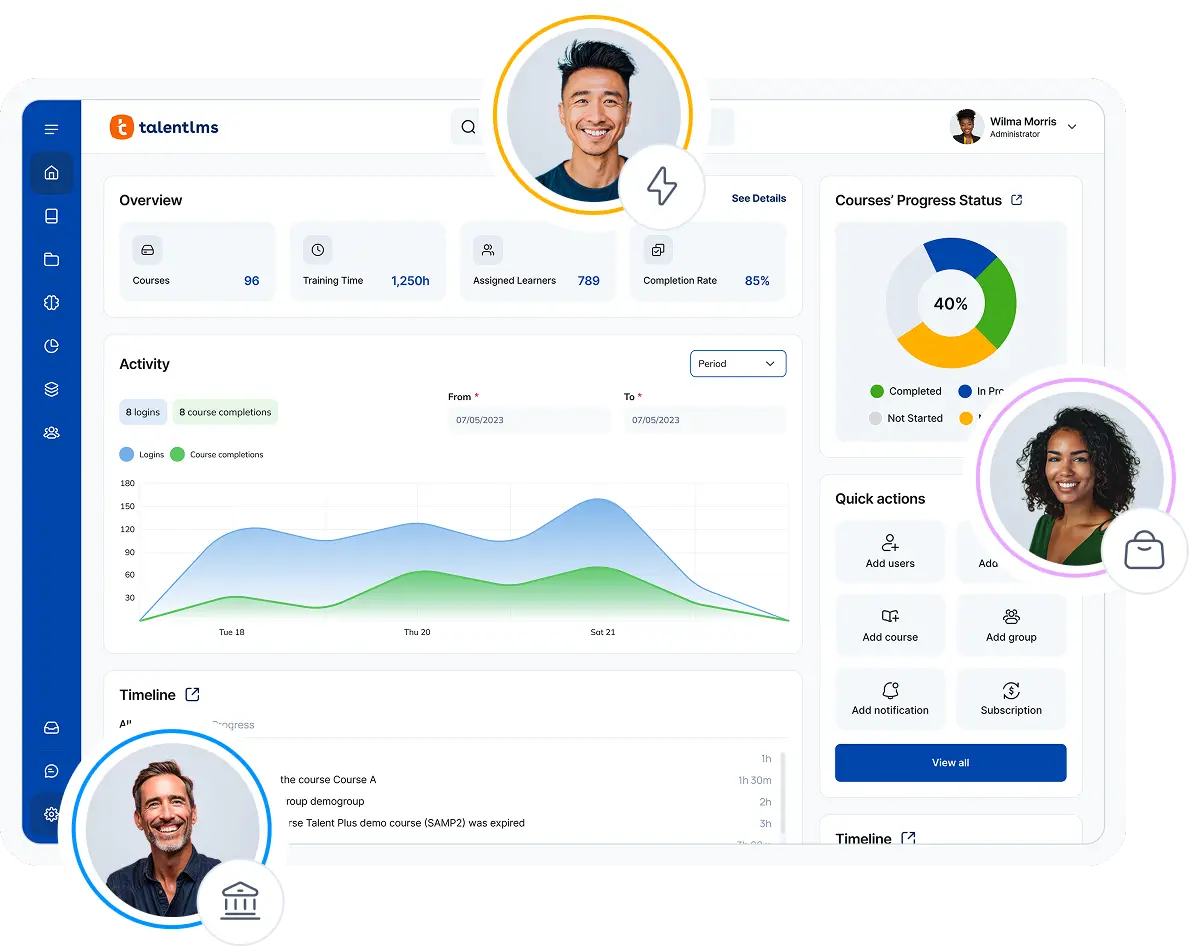Today, navigating risk in your organization is no longer just about avoiding pitfalls. It’s about identifying opportunities that will keep you at the forefront of your industry.
Effective risk management involves training your workforce.
But what do risk management training courses look like? And how can you help your team make the best opportunities out of them?
Get ready to discover how risk management training can become your organization’s secret weapon. Not just for achieving sustainable growth and for securing a competitive edge. But for avoiding financial risk too.
What is risk management and why is it important?
Risk management is the process of identifying, analyzing, and prioritizing potential threats to your organization’s goals. It’s about understanding what could go wrong, how likely it is to happen, and how severe the impact could be.
Enterprise risk management expands on this further by ensuring an integrated approach to managing risk across an organization and its extended networks.
Every organization has different risk management principles. Plus, different notions of what types of risks are acceptable.
Based around these, most businesses will establish their own limitations on how much risk they can accept. This is where company risk management (or enterprise risk management) comes in.
Managing risk has always been important. But changes like advancements in tech and the rise of hybrid and remote work mean businesses are facing more complex challenges.
Plus, these days, risk management principles aren’t just about avoiding danger. Effective risk management principles also involve recognizing and capitalizing on potential opportunities.

Example of risk management success
Say your organization faces a disruption in the supply chain. A traditional approach will mean scrambling to take care of customers in the short term. But a progressive, well-trained and confident team will also manage risk by thinking about the long term.
They will work to mitigate potential future problems. For example, exploring new suppliers.
They will discover a more reliable and cost-effective partner. And, ultimately, productivity and customer satisfaction grow as a result.
Empowering employees with the right skills to manage risk allows them to make informed decisions. It also helps them adapt to changing circumstances and achieve your organization’s goals.
What are the challenges of training for risk management?
While giving your workforce risk management skills is vital, there are hurdles to overcome in delivering effective training. Here are some key obstacles that can block the risk management process:
- Complexity of the subject. Risk management for businesses encompasses a broad range of concepts. Everything from financial risks to operational hazards. Simplifying these concepts for a diverse audience without sacrificing crucial information can be challenging.
- Keeping up with change. Regulations, industry standards, and the risk landscape itself are always evolving. Training materials and employee knowledge need to be regularly updated to match.
- Engaging learners. People can see risk management as a dry or theoretical topic. This perception can make it tricky to keep learners engaged and motivated. And if learners aren’t engaged, knowledge retention and practical application will suffer.
- Tailoring training. A “one-size-fits-all” approach won’t work. The specific risks and opportunities employees encounter will vary depending on their role and department. That means you’ll need to tailor training to address the individual needs of each group.
- Integrating with existing workflows. Training shouldn’t exist in a silo. If you want the skills to impact your results, you need to integrate them into the workflow. Which can be disruptive to everyday activities and decision-making processes.
- Addressing biases that cloud risk management decisions. Even with well-designed training, you’ll need to take human bias into account. Different people respond differently to risk and opportunity. For instance, some employees will be risk averse. They will retreat at the first sign of trouble. And will require coaching to take on challenges and opportunities. Others will be opportunists (or thrill seekers). They will step up to new possibilities. But they may need to learn how to recognize and avoid danger.
What are the benefits of risk management training?
The challenges above shouldn’t deter you. With a little planning, you can overcome them. And, the good news is, the benefits of risk management training far outweigh the obstacles.
So, what are these benefits?
There are clear advantages of good risk management, like regulatory compliance and financial benefits. But doing a risk analysis and investing in business risk management offers you additional rewards like:
- Enhanced decision-making. When they understand risks and opportunities, employees can make more informed choices. They’re better equipped to weigh up the potential consequences. And to choose the course that’s more in sync with organizational goals.
- Improved communication and collaboration. Risk management training promotes open communication about potential issues. Employees feel empowered to discuss concerns and collaborate on solutions. Which creates a more take-charge and solution-focused work environment.
- More confident workforce. Employees with skills for managing risks feel more capable in their work. They understand how their actions impact the organization. And they’re prepared to navigate challenges and contribute to achieving goals.
- Improved resilience. Training reinforces a culture of proactive management. Employees become more vigilant in identifying potential risks. And they take responsibility for diminishing them. Which, in turn, makes organizations more robust.
- Increased innovation. When they know how to reduce the risks around new ideas, employees are more likely to innovate. They’re more comfortable taking calculated risks and experimenting with new ideas.
- Improved stakeholder confidence. A proactive approach to risk management also builds trust with stakeholders. It helps clients, partners, and investors view your organization as more reliable and trustworthy.
5 useful courses around risk management training
There are different aspects to risk management training. And your employees will need varying levels of training depending on their roles and responsibilities.
General employees, for example, should only need broad risk awareness training. Operational or risk managers, however, will benefit from deeper dives into specific risk categories related to their departments.
Leaders fall into another category. They need to know how to make strategic decisions based on risk assessments. They should also understand the financial implications behind these. As a result, their training will center around the different types of risk management and how and when to use each.
Prepare your company for success by creating different risk management courses (or different learning paths) for key roles.
Here are 5 of the most important courses to consider when planning your training strategy across your organization.
Training toolkit for managing risk
1. Enterprise risk management
This course demystifies the principles of enterprise risk management for operational managers, business leaders, and business owners. Focus is on how to adopt a holistic approach that manages risk companywide, from the top down.
2. Creating a risk culture
Targeted towards business owners, managers, and leaders, this course provides practical advice on how to encourage employees to consider risk in everything they do. While still promoting innovation.
3. The 4 types of risk management
The 4 risk management strategies are: accept, transfer, avoid, and reduce. Help operational managers learn about each one, so they understand how to select the right approach when managing risk.
4. Scenario planning & risk management
Give managers and leaders the strategies and skills they need to handle “what if” situations effectively when they arise. This course is great for leaders who want to stay one step ahead.
5. Managing project risk
Heading a well-informed team that shares information on risks effectively, will help safeguard your project from pitfalls and failure. Help project managers and leaders put effective risk management measures in place.
7 risk management best practices
Effective risk management starts with good risk management training courses.
But it also goes beyond that.
It involves embedding a proactive approach into your organization’s DNA. Here are some key best practices to consider as you plan out your risk management strategy:
1. Let employees practice identifying and mitigating risks
Train employees using interactive workshops, simulations, and case studies. This will hone their ability to identify potential threats and develop strategies for handling or eliminating them.
Include hands-on planning and practice so the skills become second nature. Role-playing exercises can be particularly effective in this area.
2. Establish a consistent vocabulary and consistent processes
Complex risks can result in misunderstandings and misaligned efforts. Different ways of talking about or seeing threats can affect how people understand the severity of the issue. They can also lead to vague guidelines around who should handle the threat.
Training that promotes better risk management practices can help you avoid these pitfalls. It lets you establish consistency in your approach. And provides a shared terminology and set of processes to fall back on.
3. Offer supportive resources
Make sure the skills and risk management processes you teach show up in real, on-the-job interactions. Give employees easy-to-access resources so they have the information and tools they need to manage risk in the moment. These might include the following:
- Risk management plan. Carry out a risk analysis and develop a comprehensive and up-to-date risk management plan. It should outline risk identification, assessment, mitigation, and the effective monitoring of risk management processes. This will help employees refresh what they learned in training and give them just-in-time support as they navigate risks and opportunities.
- Risk assessment tools. Use technology-driven risk assessment tools to streamline risk identification, categorization, and prioritization. These tools can also aid in data analysis to identify emerging trends and patterns.
4. Run follow-up sessions
Help employees retain and use what they learned in training with regular follow-up activities.
For instance, conduct scenario planning exercises to prepare for potential crises and disruptions. This allows employees to test the strategies and identify areas for improvement.
You might also want to run crisis management drills. Use them to help employees test their communication protocols, emergency response procedures, and decision-making abilities under pressure.
5. Get leaders on board
Leaders play a crucial role in fostering a risk-aware culture. Ask them to participate in training. And encourage them to communicate the importance of your risk management program.
6. Make it safe to talk about risks
Encourage open communication about risks throughout your organization. Employees should feel empowered to voice concerns. They should also feel comfortable taking part in risk identification and mitigation efforts.
You can support them by adding questions about risk management concerns to performance reviews. Or by holding regular discussions around potential risks in team or company meetings.
7. Use technology to support your training efforts
Leverage online learning platforms and mobile applications to make training more flexible and accessible. Offering online courses and risk management training modules makes it easier for employees can engage with the training. Which increases the likelihood of engaging with the content.
Turning threats into opportunities
Risk management is often seen as a way to avoid danger. But it’s important to remember that it’s different from crisis management. One of the most crucial differences is its potential to unlock hidden opportunities.
The key to helping employees recognize and act on these opportunities is the right mindset and preparation.
Training equips your workforce with the skills and knowledge to navigate risks effectively. It empowers them to turn challenges into advantages. With the right training, your organization can mitigate risks and seize opportunities for a more successful and innovative future.





